TABLE ADVICE
The (brief) history of table tennis
The table is an important and eponymous component in table tennis. The beginnings of table tennis go back to the 19th century in England. During industrialisation, tennis became a very popular leisure activity at the beginning of the 19th century, especially for the upper and middle classes. So popular, in fact, that people wanted to play tennis everywhere. Since tennis courts were not available everywhere, people soon started to play on normal tables outside in the open air. And in the rainy weather, which was very common in England, the game could quickly be moved indoors. In 1875, the first table tennis rules were published by the English engineer James Gibb, and for the first time there were standardised dimensions for a table tennis table. At that time, however, table tennis tables were still somewhat smaller than they are today. Over the years, one rule or another was revised and made more precise until the table tennis table became what it is today.
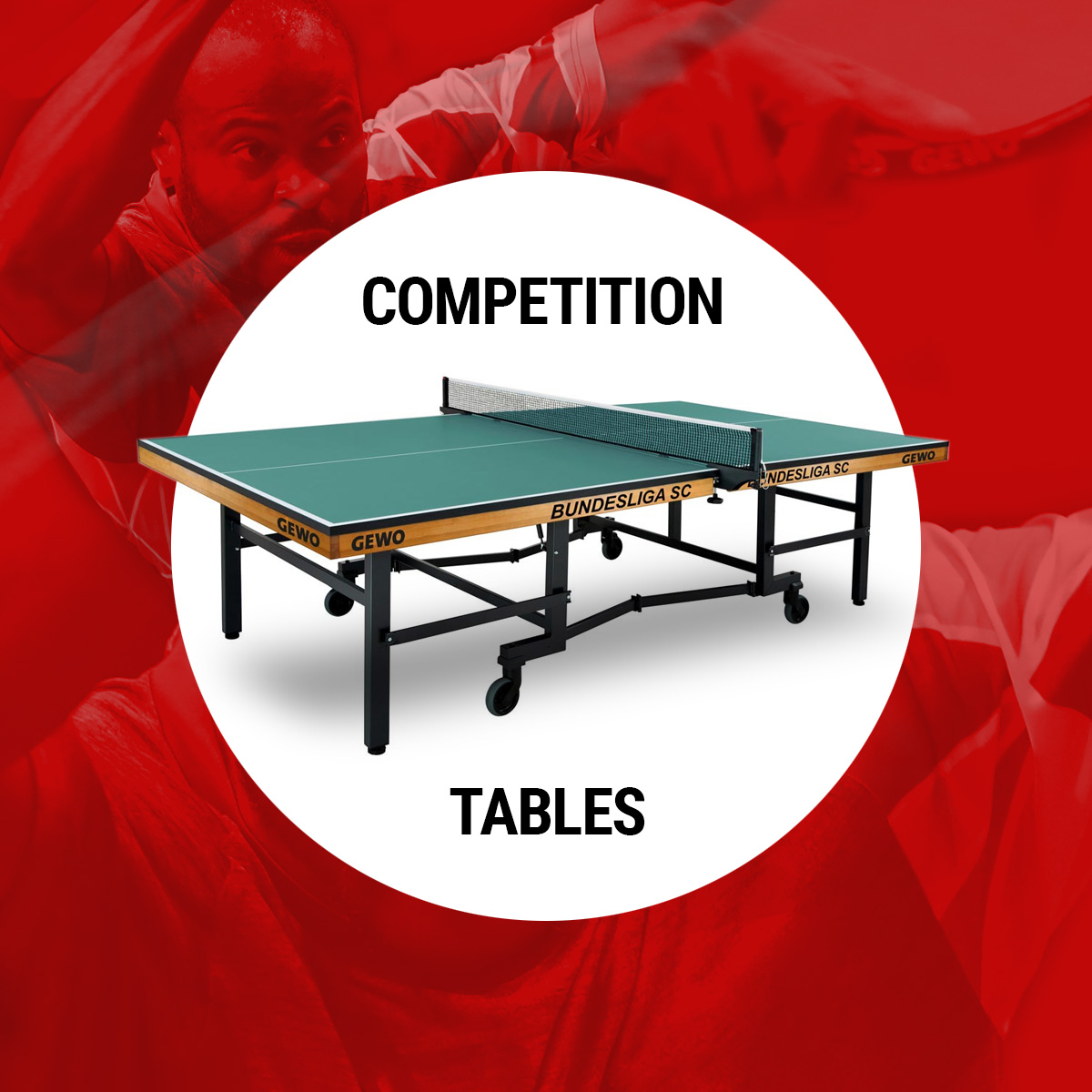
Tables for competition
For point play and tournaments, it is important that tables provide the optimal playing conditions for the athletes. The requirement for competition tables is therefore a sufficiently high and even ball bounce over the entire table surface. In order to achieve a suitable good ball bounce, a table top thickness of at least 22 millimetres is used. A thicker table top usually guarantees a higher ball bounce, which is why a table top thickness of 25 millimetres is used for most competition tables.
Tables for competition
For point play and tournaments, it is important that tables provide the optimal playing conditions for the athletes. The requirement for competition tables is therefore a sufficiently high and even ball bounce over the entire table surface.

In order to achieve a suitable good ball bounce, a table top thickness of at least 22 millimetres is used. A thicker table top usually guarantees a higher ball bounce, which is why a table top thickness of 25 millimetres is used for most competition tables.
Connecting or divisible tables
According to the ITTF specifications, table tennis tables can be divided into 4 categories.
- Separable halves without wheels
- Separable halves with wheels
- Connecting halves without automatic
- Connecting halves with automatic
Separable halves without castors, such as the GEWO Europa 25, are not as convenient to transport, which is why they are no longer commonly found in most sports halls. Nevertheless, they also offer a few advantages. For example, thanks to their two separate halves, the tables are very space-saving to store because they can be placed very close to each other. Once they are set up, the tables naturally also have a somewhat firmer stand than the versions with castors. In addition, the tables without castors are usually a little cheaper.
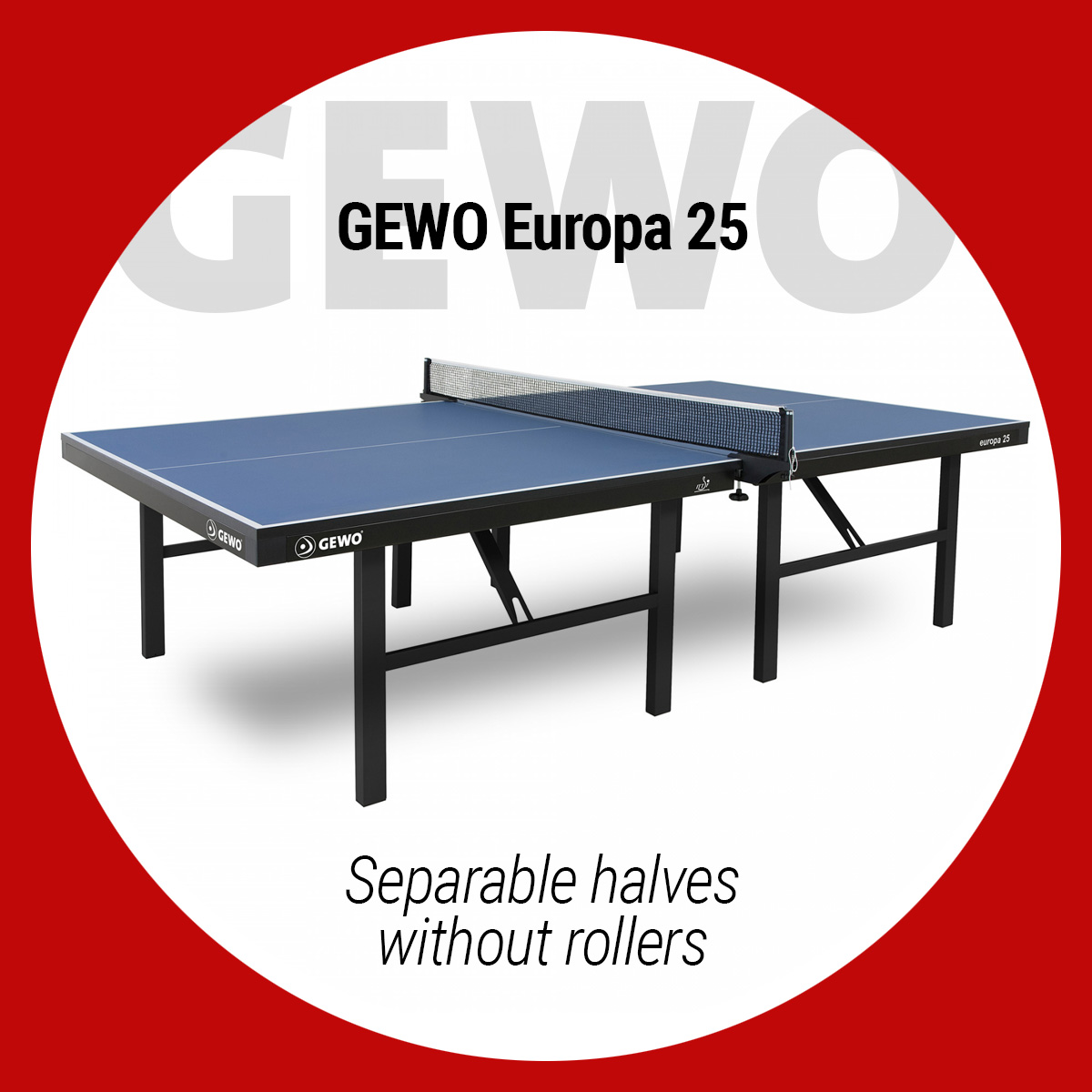
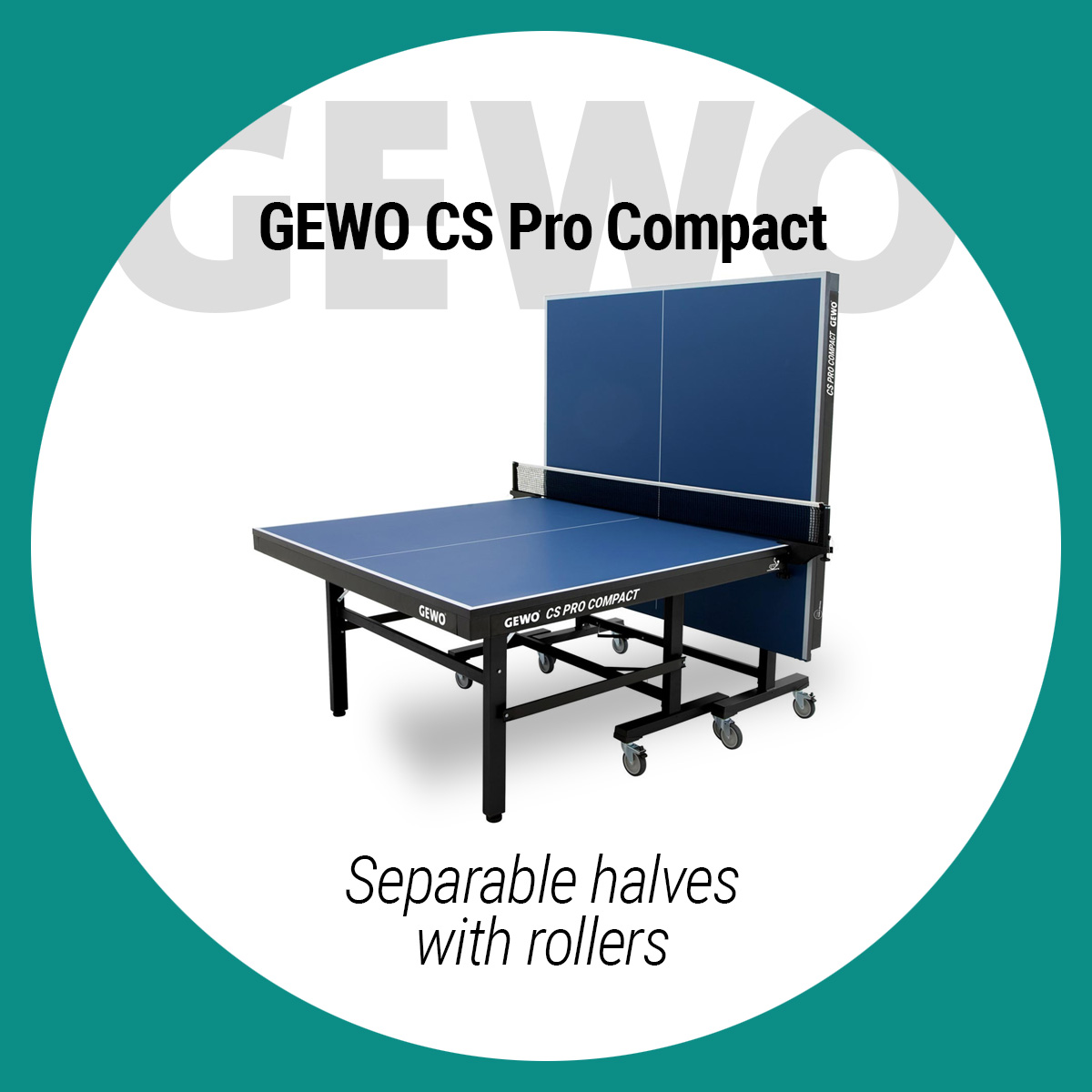
The second variant, two separable table halves with castors, requires a little more space for storage than the tables without castors because of the attached castors. Nevertheless, they can still be stowed away quite easily because they can be pushed perfectly into each other. Both variations of separable table halves also offer a great deal of flexibility when setting up. You can easily create particularly large or wide tables in any combination to provide a bit of variety during training. Another advantage of separate halves is that they can be placed in the so-called "playback" position, where one side leans upright against the other set up side. This way you can also play table tennis alone and the upright side brings the ball back and forth like a kind of return board.
The other two table variants are the connected tables. These can be divided into tables with automatic and tables without automatic. The biggest advantage of linked tables is their ease of assembly. They can be moved very quickly and easily. This saves a lot of time, especially in large sports halls, so that training can start more quickly. Tables with an automatic mechanism offer the additional advantage that both halves of the table are lowered at the same time during assembly. This is also very practical when a large number of tables are needed. However, the automatic system also prevents the table from being brought into a playback position. In addition, the biggest disadvantage of connected tables is that they take up a lot of space when they have to be put away again after training.
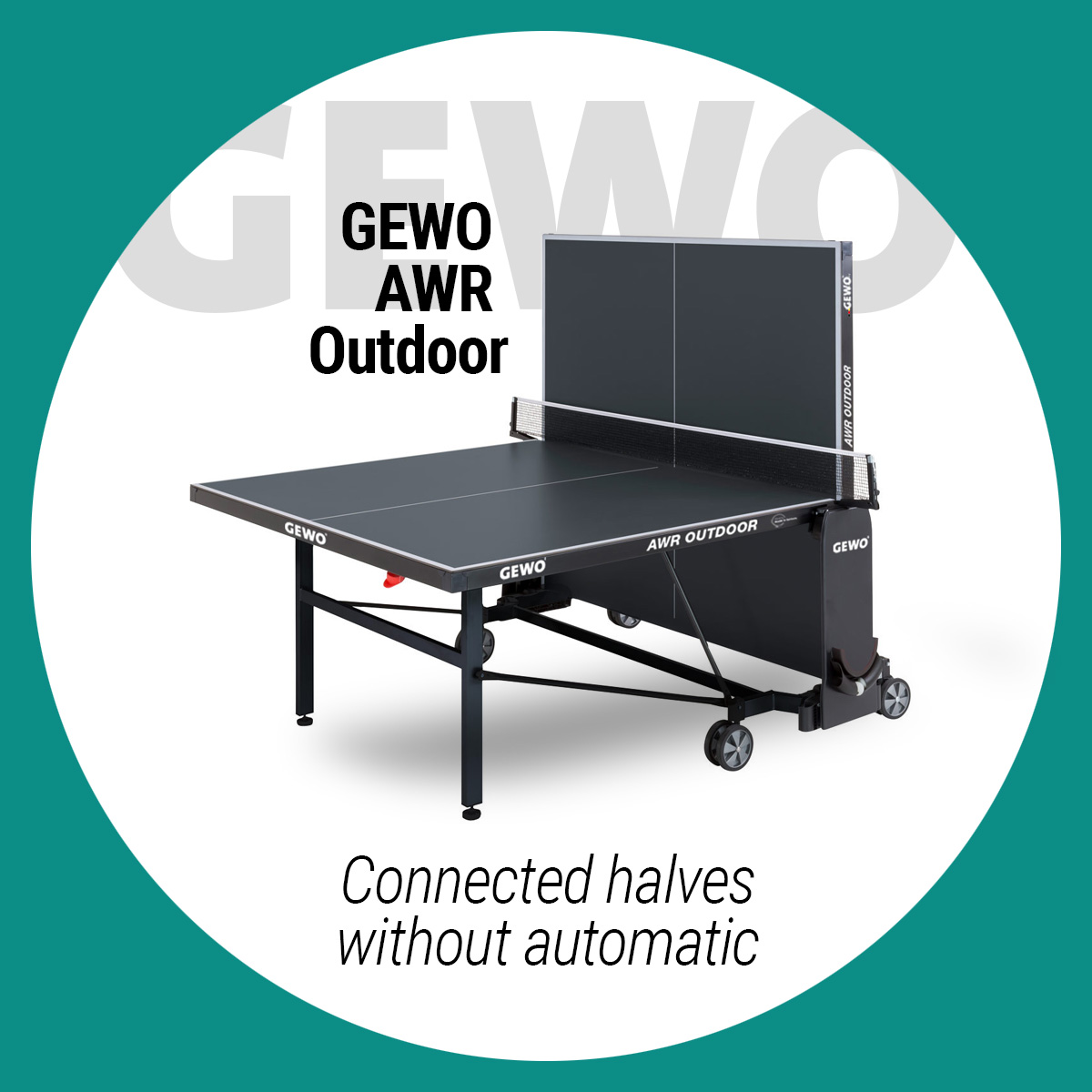
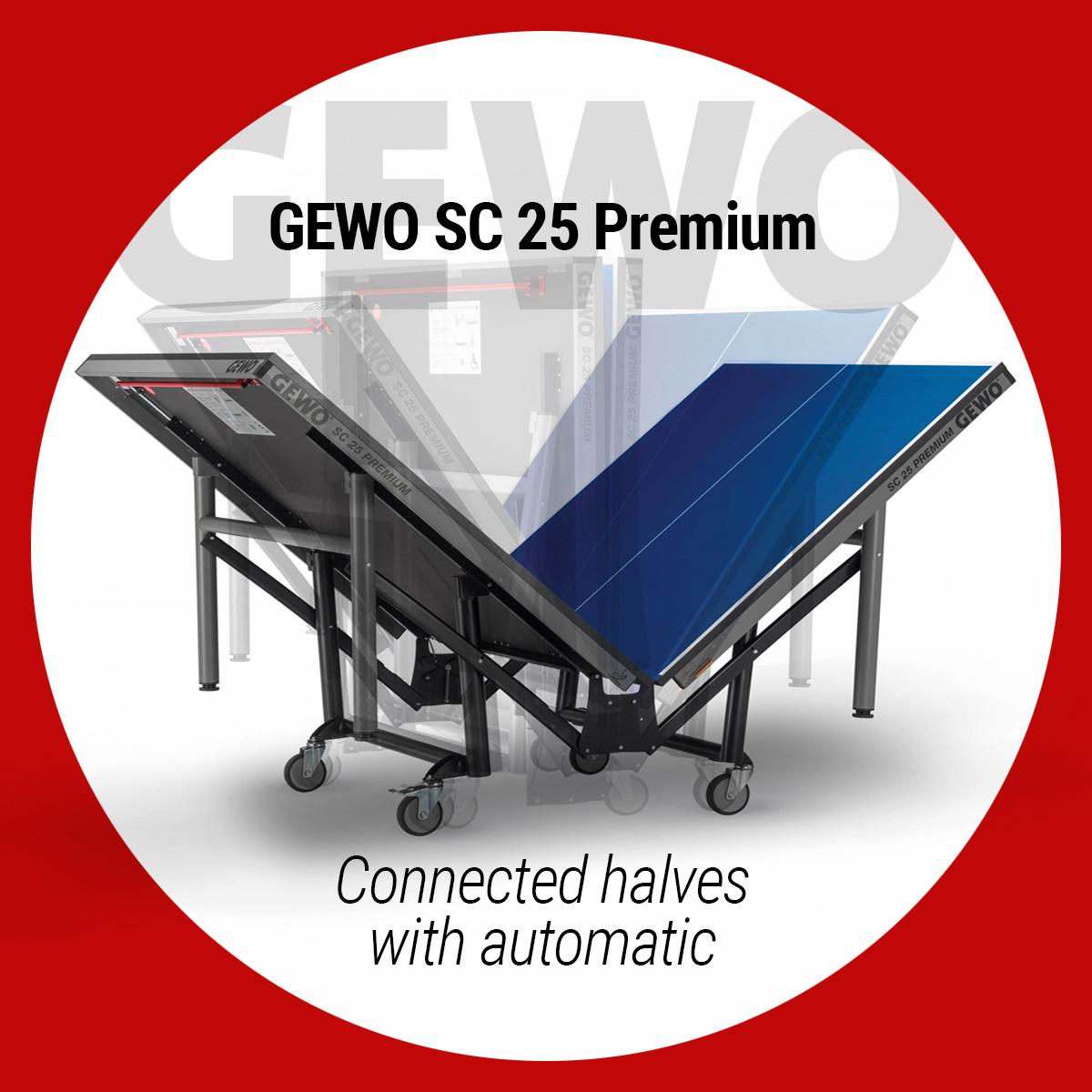
If you are unsure which of the tables are the best option for you or for your club, then you should think about the following things:
- How much space do I have to store the tables?
➔ Tables with separate halves ensure the best possible use of space in your equipment room. - Do many beginners train in my gym or would I like to play on my own?
➔ At tables that allow a playback position, beginners, even children, can play very well for a while on their own. - Do I need a lot of tables in a large sports hall?
➔ Tables with automatic lowering save you a lot of time during set-up, which you can use for training instead.
What does ITTF certification mean?
The International Table Tennis Federation (ITTF for short) is the international federation for table tennis that, among other things, sets the rules for the sport. All important guidelines for table tennis tables are regulated in an official data sheet. If a table tennis table meets these guidelines 100%, it can receive ITTF certification and thus be approved for all international competitions.
The vast majority of table tennis tables are built according to ITTF specifications. However, there are also tables that meet the most important requirements but do not have official ITTF certification. The GEWO Bundesliga SC, for example, is a table with good playing characteristics, but with its 22mm thick surface it is not officially certified. Especially in the amateur sector, the difference between a few millimetres of table thickness is hardly noticeable. For recreational use and especially outdoor table tennis tables, ITTF certification is not necessary. Nevertheless, outdoor tables typically have the dimensions of the ITTF standard. However, they cannot meet the requirements for ball bounce.
The prescribed dimensions for table tennis tables are 274 cm x 152.5 cm with a playing height of 76 cm above the floor. Furthermore, the edge and the centre must be marked on the surface with white lines. For the material, any uniform wood in a dark, uniform and matt colour may be used. The typical colours for table tennis tables are dark green, blue and anthracite.
To test the playing characteristics, a table tennis ball is dropped over the table from a height of 30 mm. For ITTF certification, the ball must bounce a minimum of 23 mm and a maximum of 26 mm.
Hobby tables
Even away from clubs and competitions, table tennis is still a great leisure activity. Whether at school or in the office, a table tennis table is a great break time activity for young and old. And for club players, too, hobby tables are a great way to play a bit at home with family, friends or colleagues. Hobby tables are available in indoor and outdoor versions. This is something you should always consider when buying a table. Usually, the vast majority of hobby tables can be easily folded and stowed away with their practical castors.
Outdoor hobby tables
Most tables for the home are outdoor tables. The simple reason for this is that table tennis tables are quite large and hardly anyone has enough space for them in the house or flat. In order to cope with the weather conditions outside, outdoor tables are not made of pure wood, but of melamine resin, aluminium composite or concrete. All three materials have advantages and disadvantages.
Aluminium composite panels consist of a wooden core enclosed in aluminium. This ensures that the playing characteristics of new boards are particularly good. However, the aluminium is quite susceptible to deformation, which means that good playing characteristics do not last very long.
Concrete tables are best suited for schoolyards or playgrounds. They offer the great advantage that they are extremely robust and can withstand even greater loads. In cold weather, however, small cracks can appear in the concrete, so that although concrete slabs also have a long durability, the play properties also deteriorate relatively quickly.
Melamine resin boards are usually the most sensible alternative for the garden. In contrast to other surfaces, they are relatively thin and therefore somewhat lighter. However, this also means that the ball bounce is quite as good. However, melamine resin surfaces are also the most durable surfaces.
Club players who are used to playing in the sports hall should definitely bear in mind that outdoor tables are primarily designed to withstand cold, sunlight and rain and are not aimed at the best playing characteristics. For this reason, experienced players in particular will notice very quickly that the balls bounce somewhat differently outdoors than indoors, and not just because of the wind. But of course this has a lot to do with habit. For recreational players, the lower ball bounce is therefore not noticeable.
Indoor hobby tables
In most cases, indoor tables are intended for clubs and schools rather than for the home. Because the tables not only take up a lot of space when set up, but are also quite bulky when stowed away, there is usually no room for indoor tables in private households. Compared to outdoor tables, however, they offer a great playing experience with uniformly good bounce characteristics over the entire table surface.
This is made of thick pressboard, which is very sensitive despite being sealed. Moisture in particular affects the tables, making them unsuitable for most garages. If you want to get an indoor table for your home, check carefully beforehand whether you have enough space and whether your storage space is sufficiently dry (humidity below 60%) and protected from other external influences. A heated garden shed is usually the best option.
Mini hobby tables
Mini tables for the home are the perfect compromise for putting a table tennis table in the living room without having to fill up the whole storeroom. Mini tables are fun for all ages. They can be set up in seconds and then you can start playing straight away. Even in club sports, it can be worthwhile to buy a mini table. They can be used to organise fun little tournaments and a mini-table can also provide some variety in everyday training for young people.
Table recommendation
To find the right table for your use, it is important to know what you need the table for in the first place. For competitions and most club use, indoor tables are a prerequisite. You should also make sure that the table surface is thick enough to guarantee the best possible playing characteristics. For this, a table thickness of at least 22 millimetres is necessary, a thickness of 25 millimetres is optimal.
For school sports, on the other hand, the playing characteristics can be largely neglected. If you want to set up the tables flexibly, sometimes indoors, sometimes outdoors, you should always opt for outdoor tables with a melamine resin surface. This way, your tables will be sufficiently protected from foreign influences even when used in the school playground. However, if you are planning to get tables exclusively for indoor use, even inexpensive indoor tables offer a better playing experience. So think carefully about how you want to use the table later. The same things should be considered for use at home. In addition, you should always keep in mind how much space you actually have available for the table.
If you are looking for a table that you can set up permanently in a public place, then you should go for a stationary, robust table. The table must be able to withstand loads and should not be easily moved. Concrete tables are ideal for this, but there are also some models with a thick melamine resin surface that are well suited for this purpose.
If you are interested in a personal consultation, please reach out to us under:
Tel.: +49 (0) 4193 - 99 18 22
or
via Email: tische@contra.de .
- Indoor
- Automatic
- Wood
- Plate 25 mm
- Indoor
- Rollers
- Wood
- Plate > 25 mm
- In-/Outdoor
- Rollers
- Wood/resin
- Plate arbitrary
- In-/Outdoor
- Rollers
- Wood/resin
- Plate arbitrary
- Outdoor
- Anchored
- Concrete/resin
- Plate > 9 mm
Tables for
competition
• Indoor
• Automatic
• Wood
• Plate 25 mm
Tables for
clubs
• Indoor
• Rollers
• Wood
• Plate > 21 mm
Tables for
school sports
• In-/Outdoor
• Rollers
• Wood/resin
• Plate arbitrary
Tables for
hobby
• In-/Outdoor
• Rollers
• Wood/resin
• Plate arbitrary
Tables for
public places
• Outdoor
• Anchored
• Concrete/resin
• Platte > 9 mm
